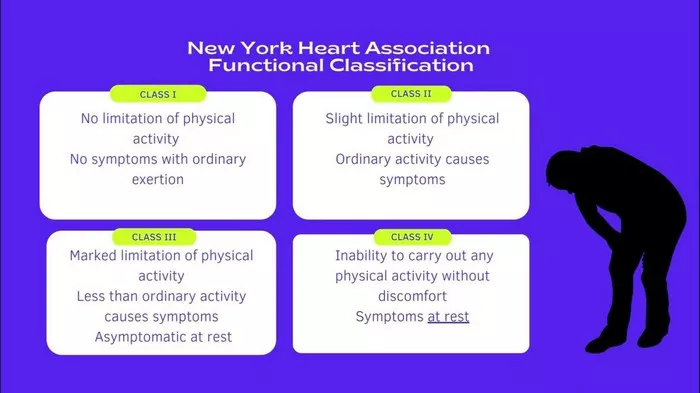Heart failure is a complex and progressive condition that affects millions of people worldwide. The New York Heart Association (NYHA) Functional Classification is a widely used system for categorizing the severity of heart failure based on a patient’s symptoms and limitations. NYHA Class 1 represents the mildest stage of heart failure, where patients have no limitations of physical activity and experience no symptoms at rest or during ordinary physical activity. This article delves into the details of NYHA Class 1, its significance in heart failure management, and what it means for patients’ quality of life.
Overview of Heart Failure
Before delving into NYHA Class 1, it’s crucial to understand heart failure itself. Heart failure doesn’t mean that the heart has stopped working; rather, it signifies that the heart is unable to pump blood efficiently to meet the body’s needs. This can lead to symptoms like shortness of breath, fatigue, swelling in the legs and abdomen, and reduced exercise tolerance.
Heart failure can be caused by various factors, including coronary artery disease, hypertension, heart valve disorders, cardiomyopathy, and other conditions that weaken the heart muscle or impair its function. It’s a chronic and progressive condition that requires ongoing management and treatment to improve symptoms, prevent complications, and enhance quality of life.
The Role of NYHA Classification
The NYHA Functional Classification is a tool used by healthcare providers to assess the severity of heart failure symptoms and determine appropriate treatment strategies. It classifies patients into four classes based on their functional limitations and symptoms:
1. NYHA Class 1: No limitations of physical activity; ordinary physical activity does not cause symptoms of heart failure.
2. NYHA Class 2: Slight limitations of physical activity; comfortable at rest, but ordinary physical activity results in symptoms of heart failure.
3. NYHA Class 3: Marked limitations of physical activity; comfortable at rest, but less than ordinary activity leads to symptoms of heart failure.
4. NYHA Class 4: Severe limitations of physical activity; symptoms of heart failure present even at rest, with any physical activity worsening these symptoms.
Each class represents a progressive increase in the severity of symptoms and limitations, with NYHA Class 1 indicating the mildest stage and NYHA Class 4 indicating the most severe stage of heart failure.
Characteristics of NYHA Class 1
NYHA Class 1 is characterized by the following key features:
1. No Limitations of Physical Activity: Patients in NYHA Class 1 can engage in ordinary physical activities without experiencing symptoms of heart failure. This includes activities like walking, climbing stairs, and light household chores.
2. No Symptoms at Rest or During Ordinary Activity: Patients do not experience symptoms such as shortness of breath, fatigue, chest pain, or palpitations while at rest or during routine physical activities.
It’s important to note that while patients in NYHA Class 1 have no limitations or symptoms during ordinary activities, they may still have underlying heart dysfunction that requires ongoing monitoring and management.
Diagnosis and Management
Diagnosing heart failure and determining the NYHA class involves a comprehensive evaluation by a healthcare provider. This typically includes a thorough medical history, physical examination, imaging tests such as echocardiography, and possibly additional tests like cardiac catheterization or stress testing.
For patients in NYHA Class 1, the focus of management is on:
1. Monitoring: Regular follow-up visits with healthcare providers to monitor symptoms, assess heart function, and adjust treatment as needed.
2. Lifestyle Modifications: Encouraging a heart-healthy lifestyle, including maintaining a balanced diet, engaging in regular exercise (as tolerated), quitting smoking, and managing stress.
3. Medications: In some cases, medications such as angiotensin-converting enzyme (ACE) inhibitors, beta-blockers, diuretics, and other heart failure medications may be prescribed to improve heart function, control symptoms, and reduce the risk of complications.
4. Education: Providing patients with education about their condition, including symptoms to watch for, medication management, dietary guidelines, and when to seek medical attention.
Prognosis and Quality of Life
The prognosis for patients in NYHA Class 1 is generally favorable compared to those in higher NYHA classes. With appropriate management and lifestyle modifications, many patients can maintain a good quality of life and continue to engage in activities they enjoy.
However, it’s essential for patients in NYHA Class 1 to adhere to their treatment plan, attend regular follow-up appointments, and communicate any changes in symptoms or concerns to their healthcare team. Heart failure is a chronic condition that requires ongoing monitoring and management to optimize outcomes and minimize the risk of disease progression or complications.
Conclusion
NYHA Class 1 represents the mildest stage of heart failure, where patients have no limitations of physical activity and experience no symptoms at rest or during ordinary physical activity. While this stage signifies a relatively stable and favorable prognosis, it’s crucial for patients to continue working closely with their healthcare providers to manage their condition effectively, maintain a healthy lifestyle, and improve their overall quality of life.

